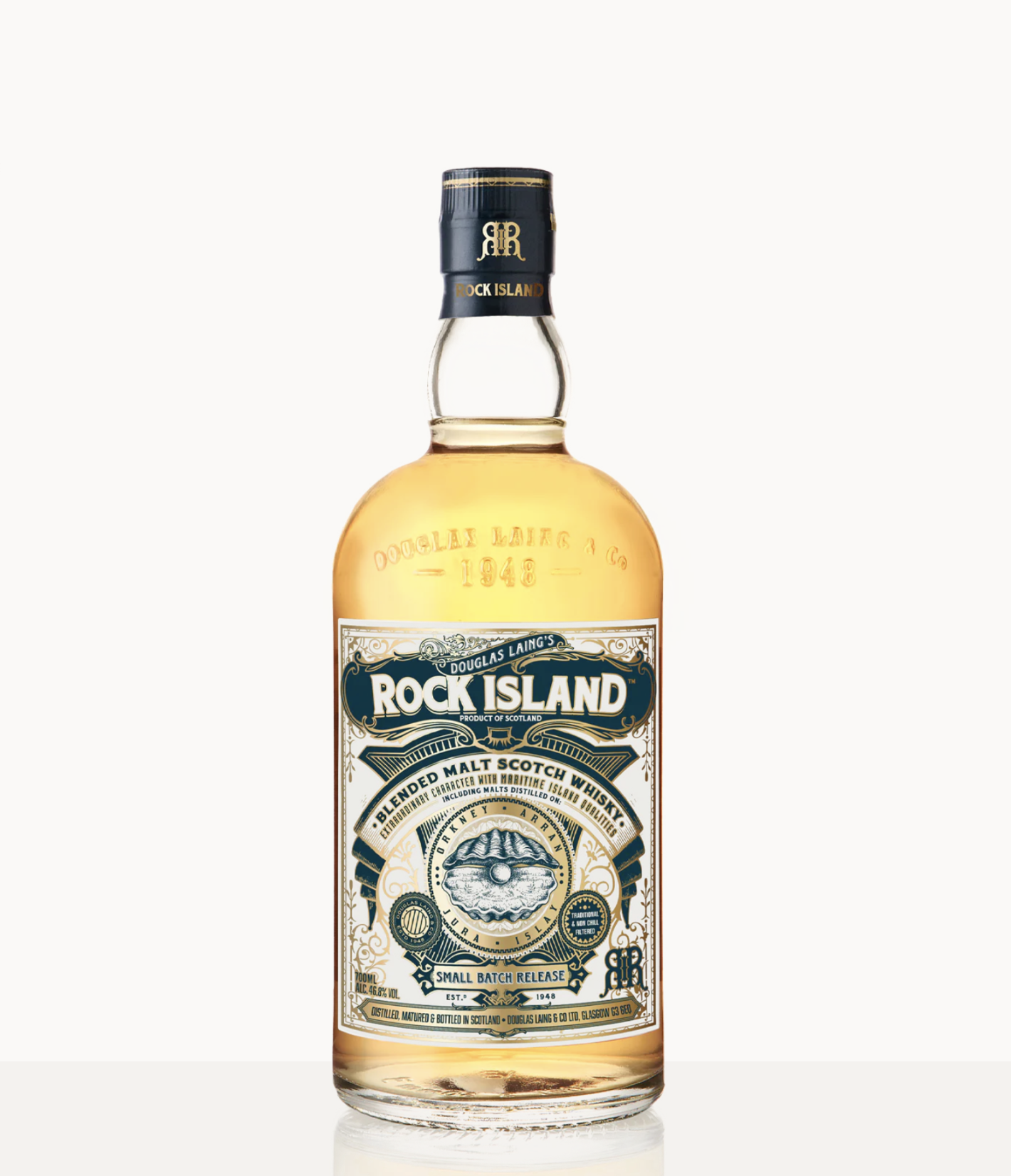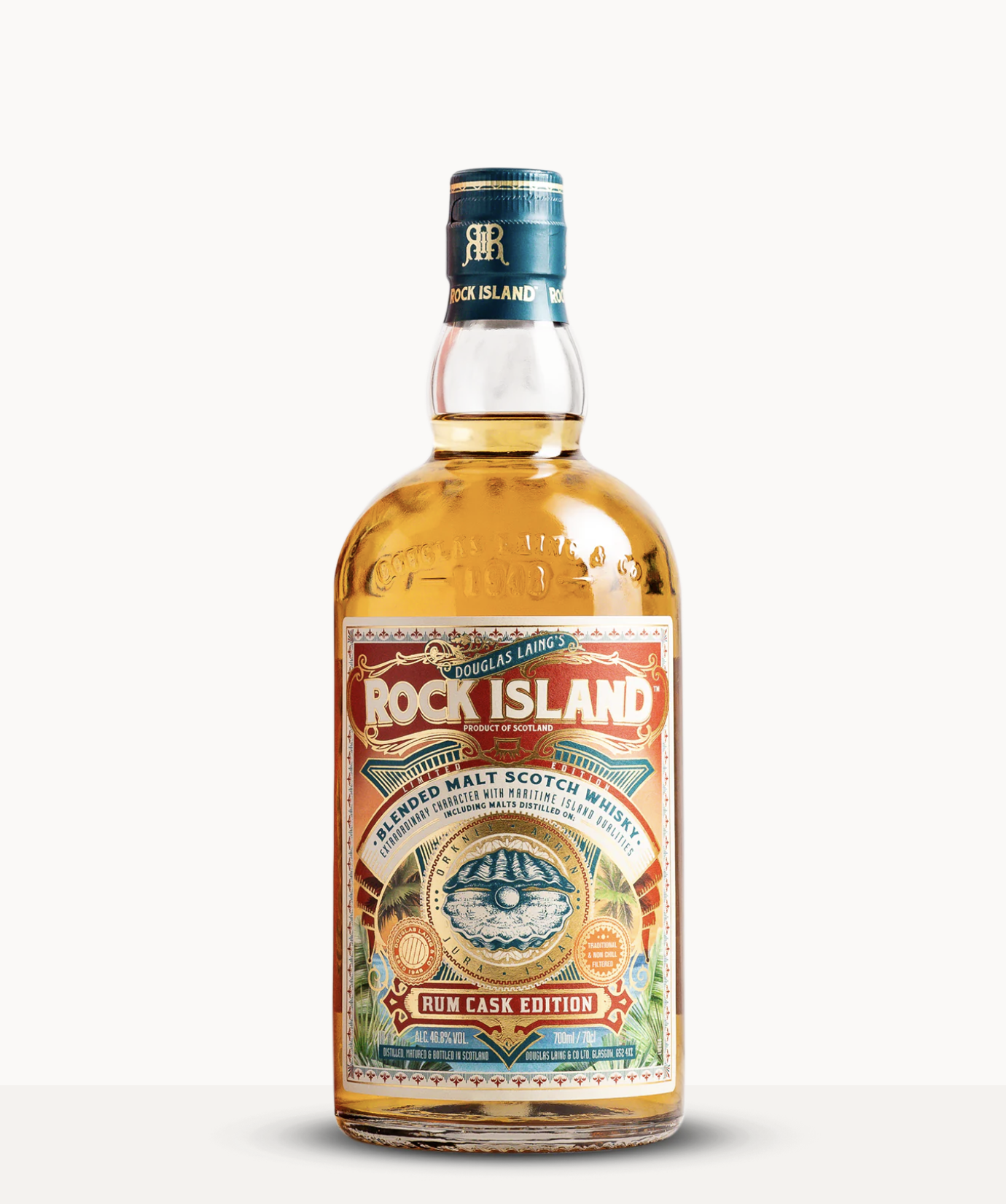Rock Island Trio
NAS, 10yo and Rum Cask Edition | 46.8% ABV
Score: 7/10
Very Good Indeed.
TL;DR
The windy shores of Scotland in a glass
Similar DNA, but very different whiskies
Blended malts are here to stay, it seems. With prices of single malt evermore creeping up, blended malts and blended scotch can offer very satisfying quality, often at a far more appealing price point than single malts.
As such ‘blended malts’ are of course nothing new, but for whatever reason, for a very long time, it seems as if the industry deliberately tried to be obscure about the whole thing.
It’s as if adding the word ‘blended’ on the label of a bottle of whisky would negatively impact the quality of its contents. It took a bit of a scandal during the 2003 deliberate attempt by Diageo to dishonestly market their Cardhu Pure Malt under the same branding as the Cardhu single malt. In the years thereafter, it took two independent whisky blender-bottlers in Compass Box and, indeed, Douglas Laing, to kickstart ‘blended malt whisky’ as an appealing category in its own right.
When Douglas Laing came up with the idea of a blended malt from Islay – aptly named Big Peat – back in 2009, they probably didn’t foresee it being the start of a series of very successful regional blended malts.
Today, the entire series comprises The Epicurean from the Lowlands, The Gauldrons from Campbeltown, Scallywag from Speyside, Timorous Beastie from The Highlands and Rock Island from (some of) the islands, alongside the aforementioned Big Peat, has grown into a steady core range – much like any successful core range of single malt in fact - around which most of Douglas Laing’s bread and butter is built.
They literally took these releases from strength to strength, regularly branching out by releasing limited releases, special finishes and age statement expressions over the past 14 years. Along the way, it seems there might have been just the one small hiccup. I’m of course referring to the fact that ‘Rock Island’ wasn’t always called that, but started out in 2015 as ‘Rock Oyster’, before getting rebranded in 2019 under its current name.
I understand why Douglas Laing dropped the name ‘Rock Oyster’ and opted for ‘Rock island’ instead. I imagine it would have been somewhere during a board meeting at DL headquarters where, after rightfully patting each other on the back for a job well done, someone from marketing brought to the attention of the board that, as much as a success the whole ‘Remarkable regional Malts’ series might well be, they would kindly like to propose a few suggestions as to further lift the brand and range. After all, where some find in oysters an absolute culinary delight, a sumptuous gift from the sea, others will easily discard them as some sort of snotty, salty goo that is best kept hidden in its shell in the first place.
To each their own, of course, but I feel it’s also a bit of a pity, seeing how calling a whisky that smells and tastes like rock and oysters ‘Rock Oyster’ absolutely hits the nail on the head.
Review 1/3
Douglas Laing Rock Island, NAS, (blended malt from Arran, Orkney, Jura and Islay), 46.8% ABV
£35 Widely available
Personally, I’m a fan of the branding of almost everything in the regional malt series. I find most of them aesthetically very pleasing and I’d even go as far as calling them ‘eye candy’, clever and distinguished. That said, I’m probably a bigger fan of the presentation than I am of some of the actual whisky. Don’t get me wrong; I don’t think there’s anything wrong with them – they taste overall absolutely decent, they’re presented naturally, at a good ABV and are priced very fairly - but most of the core range doesn’t particularly excite me either. The one exception here probably being the Rock Island series. That salty, peaty, citrus combination simply ticks a lot of my boxes.
Score: 6/10
Good stuff.
TL;DR
A rock-solid salty delight
Nose
Distinctively salty and maritime, with a sea breeze-like note, wet seaweed and beach pebbles. Sweet and sour notes coming in the shape of lemons, vanilla and honey, sitting on a savoury undertone, coming from a peculiar but interesting and appealing mixture of fungi and white chocolate.
Palate
Crisp and clean arrival, with a gentle balance of peat, salinity and citrus notes. A dry, medium mouthful led by a soft oak note, with hints of pepper and spice going into a relatively short finish.
The Dregs
This is a very in-tune, well balanced dram, with a steady, straightforward development and delivery. Granted, those maritime notes with that mixture of peat and salinity might not be for everyone, but price to quality ratio, it would be very hard to snub this.
Score: 6/10
Review 2/3
Rock island 10 year old. 2022 Release, 46.8% ABV
£40 Widely available
6/10
Good Stuff.
TL;DR
Age brings a more rounded, pleasant experience
Nose
Compared to the NAS standard expression, this 10 year old is immediately more ‘rounded’ on the nose, as it brings (toffee) apples, syrup and salted caramel. The signature salinity takes a step back, sitting in the background. Inviting and accessible, even to folk more averse to the outspoken maritime character.
Palate
The salinity makes a comeback here for sure, countering those sweeter and darker nose that translate from the nose on to the tongue. It’s more in balance now, with a lovely, warming, earthy note sitting against an gentle, pleasant peat. Both of them are laying a solid foundation on which fruity sweetness (apples, sweet oranges) and salinity add to the experience. The finish is noticeable longer too, bringing a warming mixture of salt and earthy peat.
The Dregs
While I might rate and enjoy this slightly better than the core range NAS, I’m hesitant to bump it up a full point, as that might seem as if I’m down talking the latter. Yes, they share similarities, but can you clearly tell they are different? Yes. Better? Perhaps.
Score: 6/10
Review 3/3
Rock Island Rum Cask Edition. 2023 Release, 46.8% ABV
£65 Widely available
7/10
Very Good Indeed.
TL;DR
Like a warm barbecue on Islay - an absolute crowd pleaser
Nose
Oh wow! It’s really like we’re on Islay here! The sweetness from the rum casks really pushes the peaty notes to the front. Lovely mixture of baked pineapple, smoke, peat and salinity. Pistachio nuts and roasted almonds with a whiff of chocolate and raisins rounding things off nicely.
Palate
Warm arrival with a slightly hot, peppery barbecue smokiness to it. Peaty and earthy, making it slightly but pleasantly bitter, as there are also some notes from dark chocolate to be found. The warming peat and gentle bitterness balance out the roasted nuts and baked pineapple notes, before it turns into a long, lingering and warm peat note again towards the finish.
The Dregs
Arguably, this is the least complex one in the line-up, but it’s also definitely the richest and most peat forward of the three. A very pleasant, warming, accessible and moreish dram. To be honest, I had my reservations about the combination of putting peated whisky into a rum cask, but I’m proven dead wrong here as it really works.
Score: 7/10
Final Thoughts
As I mentioned earlier, Rock Island is probably my favourite of Douglas Laing’s regional malts series. That said, the last bottle I had of this still had the name ‘Rock Oyster’ on the label, so therefore it felt good to reacquaint myself with the range, discovering something new along the way.
As things go, we try to avoid reviewing both samples and freebies here on Dramface because it’s hard to fully assess a whisky based on a sample and, more importantly, because we don’t take those words ‘fiercely independent’ in our baseline lightly. So, to be clear, I won a sample set of these 3 on an Instagram competition, and thus the opportunity presented itself to line them up and share my views and thoughts on them with you.
I ‘m absolutely confident that what you just read is my unbiased and honest opinion. I’m obviously grateful to receive something without having to pay for it, but by no means does that automatically imply that the review will be favourable.
The real value here lies in the opportunity to put these three head-to-head (to-head?) for a comparison, rather than enjoying the occasional free dram.
Tried this? Share your thoughts in the comments below. EA
-
Dramface is free.
Its fierce independence and community-focused content is funded by that same community. We don’t do ads, sponsorships or paid-for content. If you like what we do you can support us by becoming a Dramface member for the price of a magazine.
However, if you’ve found a particular article valuable, you also have the option to make a direct donation to the writer, here: buy me a dram - you’d make their day. Thank you.
For more on Dramface and our funding read our about page here.
Other opinions on this:
Whiskybase (NAS)
Whiskybase (10 year)
Whiskybase (rum cask)
Got a link to a reliable review? Tell us.






































